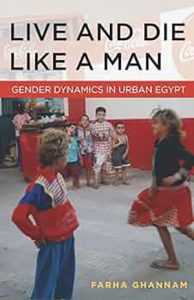Live and Die Like a Man: Gender Dynamics in Urban Egypt

Author: Farha Ghannam
Publisher: Stanford University Press
Year of Publication: 2013
Print Length: 240 pages
Genre: Non-Fiction / Anthropology
Topic: Everyday Life, Lived Experience, Testimonies, Man and Masculinity, City & Urban, Gender, Class, Age and Generation, Identity, Patriarchy, Politics & Power, Social Norms, Social Change, Violence & Mass Violence, Death & the Afterlife
Watching the revolution of January 2011, the world saw Egyptians, men and women, come together to fight for freedom and social justice. These events gave renewed urgency to the fraught topic of gender in the Middle East. The role of women in public life, the meaning of manhood, and the future of gender inequalities are hotly debated by religious figures, government officials, activists, scholars, and ordinary citizens throughout Egypt. Live and Die Like a Man presents a unique twist on traditional understandings of gender and gender roles, shifting the attention to men and exploring how they are collectively “produced” as gendered subjects. It traces how masculinity is continuously maintained and reaffirmed by both men and women under changing socio-economic and political conditions.
Over a period of nearly twenty years, Farha Ghannam lived and conducted research in al-Zawiya, a low-income neighborhood not far from Tahrir Square in northern Cairo. Detailing her daily encounters and ongoing interviews, she develops life stories that reveal the everyday practices and struggles of the neighborhood over the years. We meet Hiba and her husband as they celebrate the birth of their first son and begin to teach him how to become a man; Samer, a forty-year-old man trying to find a suitable wife; Abu Hosni, who struggled with different illnesses; and other local men and women who share their reactions to the uprising and the changing situation in Egypt.
Against this backdrop of individual experiences, Ghannam develops the concept of masculine trajectories to account for the various paths men can take to embody social norms. In showing how men work to realize a “male ideal,” she counters the prevalent dehumanizing stereotypes of Middle Eastern men all too frequently reproduced in media reports, and opens new spaces for rethinking patriarchal structures and their constraining effects on both men and women.
Table of Contents
Illustrations
Acknowledgments
Introduction: Masculinity in Urban Egypt
1. Uncertain Trajectories: The Joys and Sorrows of Boyhood
2. Plans and Stands: The Challenge of Being Single at Forty
3. Women and the Making of Proper Men
4. Gendered Violence: Local and National Articulations
5. Sickness, Death, and a Good Ending Conclusion: Masculine Trajectories and National Paths
Notes
Glossary
Bibliography
Index

Farha Ghannam is the Eugene Lang Research Professor of Anthropology at Swarthmore College. Her research and teaching interests include urban life, spatial practices, embodiment, gender, food and taste, and class politics. She is the author of Live and Die like a Man: Gender Dynamics in Urban Egypt (Stanford 2013) and Remaking the Modern: Space, Relocation, and the Politics of Identity in a Global Cairo (California 2002). Currently, she is working on a book entitled “The Gender of Class: Social Inequalities in Urban Egypt.” Her work has appeared in several journals including the American Ethnologist, Visual Anthropology, the Journal of Middle Eastern Studies, City and Society, and Ethnos. She is the president of the Association for Middle East Anthropology (AMEA). Before AMEA, she had served as the president of the Middle East Section of the AAA.
Source: https://mec.sas.upenn.edu/people/farha-ghannam
More from Farha Ghannam in this library, click here.
